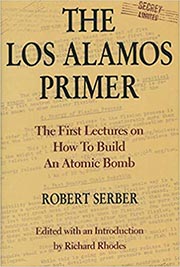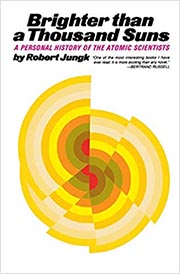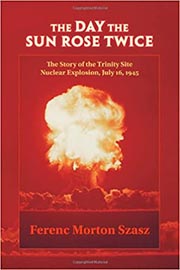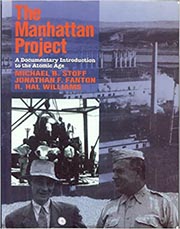Selected Biography
-

The Making of the Atomic Bomb
by Richard Rhodes
Richard Rhodes takes us on that journey step by step, minute by minute, and gives us the definitive story of man's most awesome discovery and invention. This book was awarded the 1988 Pulitzer Prize. -

Racing for the Bomb: General Leslie R. Groves, the Manhattan Project's Indispensable Man
by Robert S. Norris
Racing for the Bomb tells the gripping story of how Groves - more than any single scientist - was crucial to the Manhattan Project's success. Robert Norris portrays Groves at center stage making nearly every key decision to build, test, and use the bomb. -

The Los Alamos Primer: The First Lectures on How to Build an Atomic Bomb
by Robert Serber
These lectures were given to newly arriving scientist working the Manhattan Project in 1943. Working with Richard Rhodes, Professor Serber has annotated his original lecture notes with explanations of the physics terms for the nonspecialist. -

Manhattan Project : The Untold Story of the Making of the Atomic Bomb
by Stephane Groueff
A non-technical narrative of the actual making of the first atomic bomb with an accent on the personal cases of the participants and the industrial companies that built it. Rich of human stories and anecdotes. -

Now it Can Be Told: the Story of the Manhattan Project
by Leslie R. Groves
his is an autobiographical account by the military head of the Manhattan Project, Leslie Groves. Groves describes his leadership of the Manhattan Project from its beginnings in 1942 to the early postwar period when the Atomic Energy Commission (AEC) assumed responsibility for nuclear weapons and programs. -

Brighter than a Thousand Suns
by Robert Junck
This book is a chronological account of the scientific research and the social climate that led to the creation of the first atomic bomb, and what happened in the few years after two were dropped on Japan. -

The Decision to Use the Atomic Bomb
by Gar Alperovitz
Controversial in nature, this book demonstrates that the United States did not need to use the atomic bomb against Japan. Alperovitz criticizes one of the most hotly debated precursory events to the Cold War, an event that was largely responsible for the evolution of post-World War II American politics and culture. -

Prompt and Utter Destruction: President Truman and the Use of Atomic Bombs Against Japan
by J. Samuel Walker
This book is a response to what the author sees as a popular historical misconception about why the atomic bombs were dropped. Walker disputes the idea that President Harry Truman had only two options for ending the war against Japan in the summer of 1945: to drop the bomb or order a costly invasion of the Japanese mainland. He presents historical evidence to show that Truman had other options for ending the war quickly. -

The Day the Sun Rose Twice: The Story of the Trinity Site Nuclear Explosion, July 16, 1945
by Ferenc Morton Szasz
This book presents the fascinating story of the events leading up to the first atomic bomb test explosion, the characters and roles of the people involved, and the aftermath, both political and physical, of the bomb. -

Their Day in the Sun: Women of the Manhattan Project
by Ruth Howes, Caroline Herzenberg
The Manhattan Project also included women in every capacity. During World War II the manpower shortages opened the laboratory doors to women and they embraced the opportunity to demonstrate that they, too, could do "creative science." Although women participated in all aspects of the Manhattan Project, their contributions are either omitted or only mentioned briefly in most histories of the project. -

War's End: An Eyewitness Account of America's Last Atomic Mission
by Charles W. Sweeney
Maj. Gen. Charles W. Sweeney has the unique distinction of having been an integral part of both the Hiroshima and the Nagasaki bombing runs. He chronicles of the months of careful planning and training; the nerve-shattering final seconds and the aftermath of one of the most significant single event in modern history. -

British Scientists and the Manhattan Project : The Los Alamos Years
by Ferenc Morton Szasz
Tells the story of the British scientists who traveled to Los Alamos, New Mexico, and contributed to the development of the atomic bomb. Also recounts their profound influence on the postwar nuclear programs of the US, Great Britain, and the Soviet Union. -

City Behind a Fence: Oak Ridge, Tennessee
by Charles W. Johnson and Charles O. Jackson
This book chronicles the nature of daily life in Oak Ridge, Tennessee, one of the principal sites used in the construction of atomic bombs during World War II. The authors explain how many of the inhabitants had no idea what was occurring in the facility, and that they spent much of the war cut off from the outside world. -

Working on the Bomb: An Oral History of WWII Hanford
by S. L. Sanger, Craig Wollner
This book presents a history of the design, construction, and operation of the United States' top-secret plutonium manufacturing project in Hanford, Washington during World War II. -

The Manhattan Project (Cornerstones of Freedom)
by Richard Conrad Stein
Recounts the history of the crash program that resulted in the development of the atomic bomb. -

Hitler's Uranium Club : The Secret Recordings at Farm Hall
by Jeremy Bernstein
Nazi Germany's greatest nuclear physicists were detained by Allies at Farm Hall, England. This book contains the complete transcripts from the secret 1945 recordings. A startling and sobering set of documents, it provides an unprecedented view into the thoughts and feelings of these scientists as they contemplated the destruction of the Reich, their failure to deliver a bomb into Hitler's hands, and the state of their own consciences. -

The Manhattan Project: Introduction to the Atomic Age
by Michael B. Stoff
The authors provide students with a documentary case study of a critical episode in modern American history. The authors allow students to learn history by doing history--or at least by asking them to read and analyze the most original sources that could be assembled. -

The American Atom: A Documentary History of Nuclear Policies from the Discovery of Fission to the Present
by Philip L. Cantelon, Richard G. Hewett, Robert C. Williams
An extensive collection of primary documents that tells the story of atomic energy in the United States from the discovery of fission, through the development of nuclear weapons, to the Cold War, and attempts at control of nuclear weapons. -

Picturing the Bomb: Photographs from the Secret World of the Manhattan Project
by Rachel Fermi
This visually compelling collection of private and official photos found in family albums and laboratory archives offers a closer look at the Manhattan Project. -

Jumbo: The Secret Vessel Built to Hold an Atomic Bomb
by Frederick J Fraikor
Worried about the loss of the highly radioactive plutonium, valued at over a billion dollars, across the New Mexico desert and the surrounding communities, a containment vessel was ordered to be created. This book explores the design, construction, and eventual destruction of the vessel that became known as “Jumbo”.